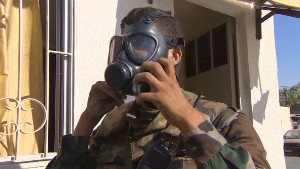Editor's note: Gwyn Winfield is editor of CBRNe World, which covers news related to chemical, biological, radiological, nuclear or explosives threats or incidents.
(CNN) -- For many, myself included, the lack of a credible third party on the ground offering some form of evidence for the nature of Wednesday's mass killing in a suburb of Damascus was a major stumbling block.
But Saturday's announcement by Doctors without Borders turned that around, giving credence to the likelihood that it was an attack involving some form of nerve agent.
The organization said that three hospitals it supports reported that they had treated 3,600 patients with "neurotoxic symptoms" in a span of less than three hours and that 355 of those had died.
UN chemical weapons team comes under sniper fire
 Gwyn Winfield
Gwyn Winfield Atropine, the primary treatment for those exposed to sarin-like chemicals, can be potentially harmful if there is a misdiagnosis and nerve agent is not present. But the sheer number of patients that have responded to this treatment makes it impossible to state that these lethal agents were not present.
It also makes the job of the U.N. inspectors even more difficult.
Since they were not allowed access to the casualties inside the vital 48-hour window that would allow clear identification through analysis of blood, hair and clothes before the chemical started to degrade, they are reliant on samples that might have been gathered by biased activists or on soil and water samples from the site.
The subsequent decision by President Bashar al-Assad's regime to let the inspectors into the area is not likely to provide conclusive evidence for those wishing to attribute the attacks to one side or another.
The soil and water collected can give only a "best guess," as many of the samples will be contaminated by what might be considered normal battlefield chemicals, including whatever rocket fuel powered the devices, explosive degradation materials from shells and mortars as well as other chemicals released by the explosive power of the barrage such as diesel fuel or household cleaners and pesticides.
Suffering in Syria is clear, but cause and culprits are murky
 U.N. team fired on in Syria
U.N. team fired on in Syria  Syria agrees to let U.N. investigate
Syria agrees to let U.N. investigate  Obama's Syria problem
Obama's Syria problem Now the inspectors will have to cast a wide net to try and find a sampling site that has stronger evidence of nerve agent which isn't hidden by other chemicals dispersed through the destruction of industrial, commercial and residential properties.
The exact agent used on Wednesday is still not known, but it appears to contain a nerve toxin, like sarin, combined with other elements.
From the symptoms seen in the videos, the chemical weapon may be of lower toxicity than traditional nerve agents and may have been mixed with other substances that are likely to remain in the environment longer than sarin gas, which dissipates quickly.
Whatever the chemical is, it may well have come from the Assad regime's stocks, but that is not to suggest the Syrian government forces necessarily launched it.
The inspectors would need to to have complete access to Syrian files. Should they be allowed the time to forensically analyze the chemical, they could get a chemical fingerprint that will tie it to a batch of product that has this exact fit.
Then the inspectors would need to know what the serial numbers were on all the munitions containing this batch, and they would then be able to account for any missing serial numbered munitions. This would be a process that would take months, if not years, even with the willing assistance of the Assad regime.
Part of the sampling process would involve finding the munitions used to deliver the chemical agent and swabbing them to get a "pure" sample, but from the way that crowds have been handling these devices, they clearly no longer contain any significant traces of nerve agent. Indeed it is hard to say definitively that the munitions shown in the pictures were the ones used in the apparent chemical attack.
The inspectors are now placed in the invidious position of being unable to provide the information that the West is clamoring for in either the required detail or time frame. They are now also likely to have their job further complicated by announcements from various militaries based on the satellite imagery analysis that they have done and on any samples that might have been taken from the scene earlier.
Intelligence analysts who have access to signals intercepts, showing which military units were where at given times, and satellite images of the various firing positions will help to point a finger at a likely suspect. The balance of opinion seems to be falling onto the chemicals being rocket launched, and there are doubts whether the rebels have any rocket batteries. (Though it wouldn't be the first time that a nontraditional military surprised us).
Chemical weapons frightful, inexpensive
Until Wednesday's attacks, the U.N. inspectors were expected to be a footnote, with a limited mandate and constrained to only three sites, but now they have found themselves flung into a situation for which they have not been equipped, either politically or technically.
As the pressure for action grows, the most likely scenario will be a request to replace, or augment, the current team with one that is able to perform the task that Western nations want of it.
In a way, this is unfair to Ake Sellstrom and his team. They were designed to be a screwdriver, not a jackhammer, and are only working under the mandate that the United Nations provided them.
It is unlikely that access to the site this week will provide the response that Sens. John McCain and Lindsey Graham will want.
All it will dig up is more questions.
Follow us on Twitter @CNNOpinion.
Join us on Facebook/CNNOpinion.
{ 0 comments... read them below or add one }
Post a Comment